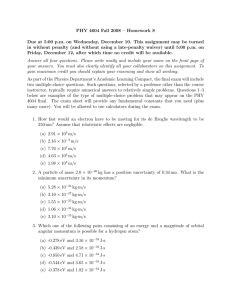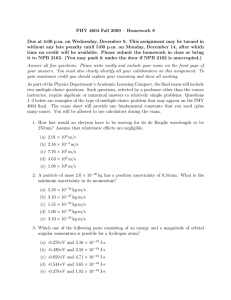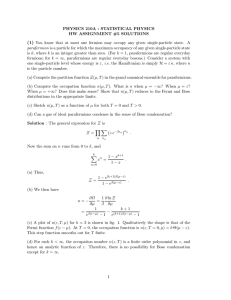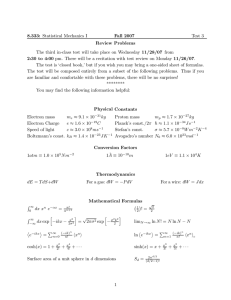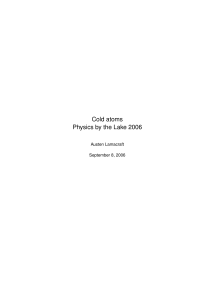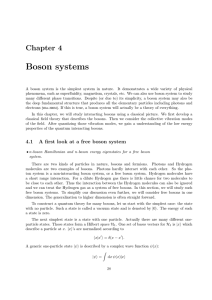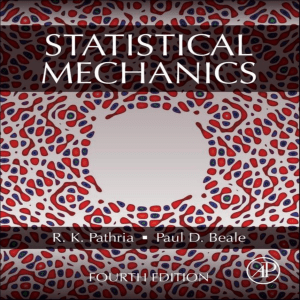(1)
advertisement
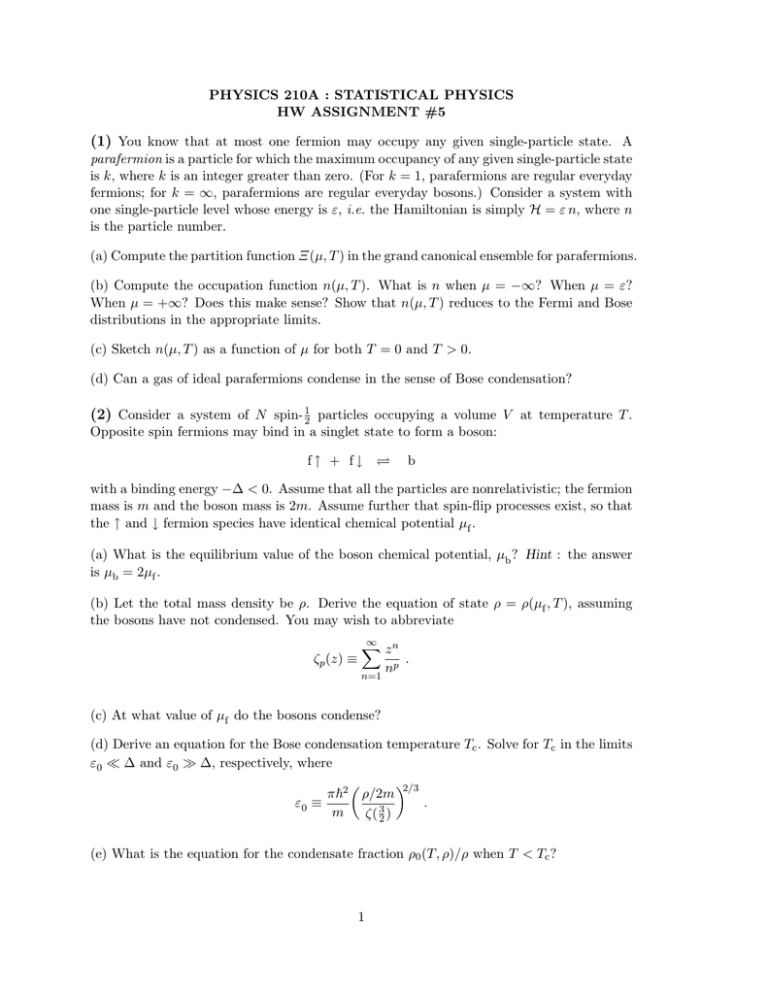
PHYSICS 210A : STATISTICAL PHYSICS HW ASSIGNMENT #5 (1) You know that at most one fermion may occupy any given single-particle state. A parafermion is a particle for which the maximum occupancy of any given single-particle state is k, where k is an integer greater than zero. (For k = 1, parafermions are regular everyday fermions; for k = ∞, parafermions are regular everyday bosons.) Consider a system with one single-particle level whose energy is ε, i.e. the Hamiltonian is simply H = ε n, where n is the particle number. (a) Compute the partition function Ξ(µ, T ) in the grand canonical ensemble for parafermions. (b) Compute the occupation function n(µ, T ). What is n when µ = −∞? When µ = ε? When µ = +∞? Does this make sense? Show that n(µ, T ) reduces to the Fermi and Bose distributions in the appropriate limits. (c) Sketch n(µ, T ) as a function of µ for both T = 0 and T > 0. (d) Can a gas of ideal parafermions condense in the sense of Bose condensation? (2) Consider a system of N spin- 12 particles occupying a volume V at temperature T . Opposite spin fermions may bind in a singlet state to form a boson: f↑ + f↓ b with a binding energy −∆ < 0. Assume that all the particles are nonrelativistic; the fermion mass is m and the boson mass is 2m. Assume further that spin-flip processes exist, so that the ↑ and ↓ fermion species have identical chemical potential µf . (a) What is the equilibrium value of the boson chemical potential, µb ? Hint : the answer is µb = 2µf . (b) Let the total mass density be ρ. Derive the equation of state ρ = ρ(µf , T ), assuming the bosons have not condensed. You may wish to abbreviate ∞ X zn ζp (z) ≡ n=1 np . (c) At what value of µf do the bosons condense? (d) Derive an equation for the Bose condensation temperature Tc . Solve for Tc in the limits ε0 ∆ and ε0 ∆, respectively, where ε0 ≡ π~2 m ρ/2m ζ( 32 ) 2/3 . (e) What is the equation for the condensate fraction ρ0 (T, ρ)/ρ when T < Tc ? 1 (3) A three-dimensional system of spin-0 bosonic particles obeys the dispersion relation ε(k) = ∆ + ~2 k2 . 2m The quantity ∆ is the formation energy and m the mass of each particle. These particles are not conserved – they may be created and destroyed at the boundaries of their environment. (A possible example: vacancies in a crystalline lattice.) The Hamiltonian for these particles is X U ε(k) n̂k + H= N̂ 2 , 2V k P where n̂k is the number operator for particles with wavevector k, N̂ = k n̂k is the total number of particles, V is the volume of the system, and U is an interaction potential. (a) Treat the interaction term within mean field theory. That is, define N̂ = hN̂ i + δ N̂ , where hN̂ i is the thermodynamic average of N̂ , and derive the mean field self-consistency equation for the number density ρ = hN̂ i/V by neglecting terms quadratic in the fluctuations δ N̂ . Show that the mean field Hamiltonian is i Xh HMF = − 12 V U ρ2 + ε(k) + U ρ n̂k , k (b) Derive the criterion for Bose condensation. Show that this requires ∆ < 0. For ∆ = −|∆0 |, find an equation relating Tc , U , and ∆0 . (4) The nth moment of the normalized Gaussian distribution P (x) = (2π)−1/2 exp − 21 x2 is defined by 1 hx i = √ 2π n Z∞ dx xn exp − 21 x2 −∞ Clearly hxn i = 0 if n is a nonnegative odd integer. Next consider the generating function 1 Z(j) = √ 2π Z∞ dx exp − 12 x2 exp(jx) = exp 1 2 2j −∞ (a) Show that nZ d hxn i = n dj and provide an explicit result for hx2k i j=0 where k ∈ N. (b) Now consider the following integral: 1 F (λ) = √ 2π Z∞ dx exp − 21 x2 − −∞ 2 4 1 4!λ x . . This has no analytic solution but we may express the result as a power series in the pa λ 4 rameter λ by Taylor expanding exp − 4 ! x and then using the result of part (a) for the moments hx4k i. Find the coefficients in the perturbation expansion, F (λ) = ∞ X Ck λk . k=0 (c) Define the remainder after N terms as RN (λ) = F (λ) − N X Ck λ k . k=0 Compute RN (λ) by evaluating numerically the integral for F (λ) (using Mathematica or some other numerical package) and subtracting the finite sum. Then define the ratio SN (λ) = RN (λ)/F (λ), which is the relative error from the N term approximation and plot the absolute relative error SN (λ) versus N for several values of λ. (I suggest you plot the error on a log scale.) What do you find?? Try a few values of λ including λ = 0.01, λ = 0.05, λ = 0.2, λ = 0.5, λ = 1, λ = 2. 3



